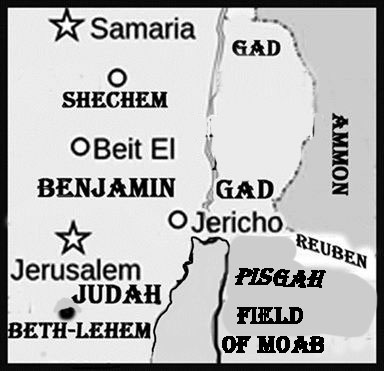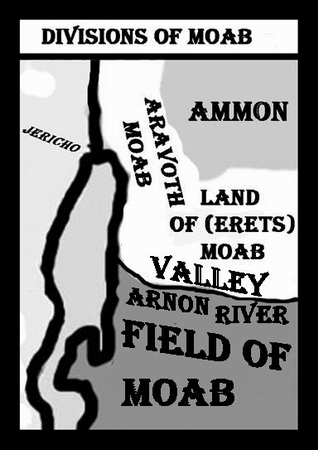Ruth Came from Moab and was a Moabitess! (3 February 2016, 24 Shevet, 5776)
Continued from Field of Moab.

Ruth in the Bible is described as a foreign women (Ruth 1:10) Hebrew: €œnocriah€), a Moabitess (Ruth 2:10) who came from the €œField of Moab€ (Ruth 1:1, 2, 6) meaning the Country of Moab that Moabites dwelt in.
Even Wikipedia Agrees with us!
Moab
From Wikipedia, the free encyclopedia
The territory occupied by Moab at the period of its greatest extent, before the invasion of the Amorites, divided itself naturally into three distinct and independent portions: The enclosed corner or canton south of the Arnon (referred to as "Field of Moab")[ Ruth 1:1,2,6]; the more open rolling country north of the Arnon, opposite Jericho and up to the hills of Gilead (called the "land of Moab")[Deuteronomy 1:5; 32:49 ]; and the district below sea level in the tropical depths of the Jordan valley.[Numbers 22:1].
In Other Words the land of Moab was divided into three different areas according to Biblical Terminology. The terms used referring to areas once belonging to Moab and were only applicable PRIOR to the conquest and allocation of the Land Conquered to Israelite Tribes.
The three divisions were:
1. 'Aravoth Moab' in the savannah lands east of the Jordan and opposite Jericho. Later given to Reuben and Gad.
2. 'Land of [in Hebrew, 'Erets'] Moab' north of the Arnon River. This region was later given to Reuben.
'Aravoth Moab' together with 'Erets Moab' were first conquered by the Amorites and then the Israelites conquered these areas from them.
'Erets' in Hebrew means 'land' or 'earth.' It parallels the English word 'land.'
The "Online Etymological Dictionary" defines 'land' as:
#Old English land, lond, "ground, soil," also "definite portion of the earth's surface, home region of a person or a people, territory marked by political boundaries," from Proto-Germanic *landom' #
In this context Land of ['Erets' Moab] in Biblical usages would imply the land with which Moab was associated.
3. Field of [in Hebrew, 'Sadeh'] Moab south of the Arnon River. This region remained in the possession of Moab. This is where Ruth came from. Wherever the word 'Moab' is found in the Book of Ruth it is given as 'Sadeh Moab' (Ruth 1:1,2,6).
The Hebrew expression 'Sadeh Moab' is translated as 'Field of Moab.' It connotes 'expanse belonging to.' It is beset paralleled by the English word 'country.'
The "Online Etymological Dictionary" defines 'country' as:
# Mid-13c., "district, native land," from Old French contree, from Vulgar Latin *(terra) contrata "(land) lying opposite," or "(land) spread before one," . #
We may conclude that 'Land of ['Erets'] Moab' implies the area once associated with Moab whether it still belonged to Moab or not. Similarly we have the expressions 'Land of Canaan' (Psalm 105:11), and 'Land of Israel' (Ezekiel 20:42), etc.
On the other hand 'Field of ['Sedeh'] Moab' connotes the region in which Moabites were living at the time spoken of. Similarly the 'Field of the Amalekites' (Genesis 14:7) means the Country of the Amalekites at the time but not necessarily the area previously associated with them. The same applies to the 'Field of Edom' (Genesis 32:4); and the 'Field of the Philistines' (1-Samuel 6:1), etc.
We found the term 'Field of ['Sedeh'] Moab' 3 times in the Book of Moab and another 3 times elsewhere in the Bible, i.e. Ruth 1:1, 2, 6; Genesis 36:35; 1-Chronicles 8:8; and Numbers 21:20.
Numbers 21:20 mentions the Journeying Israelites coming to the borders of Israel and reaching up to 'the Valley which is in the Field of Moab.' Scripture tells us that the Israelites had just reached the border of the People of Moab:
Numbers 21:
13 From there they journeyed and camped on the other side of the Arnon, which is in the wilderness that comes out of the border of the Amorites, for the Arnon is the border of Moab, between Moab and the Amorites.
All the other references to the 'Field of Moab' also fit areas peopled by Moabites. Whatever the case, the Book of Moab is what interests us:
Ruth 1: (NASB adapted):
1 Now it came about in the days when the judges governed, that there was a famine in the land. And a certain man of Bethlehem in Judah went to sojourn in the FIELD OF MOAB with his wife and his two sons. 2 The name of the man was Elimelech, and the name of his wife, Naomi; and the names of his two sons were Mahlon and Chilion, Ephrathites of Bethlehem in Judah. Now they entered the FIELD OF MOAB and remained there. 3 Then Elimelech, Naomis husband, died; and she was left with her two sons. 4 They took for themselves Moabite women as wives; the name of the one was Orpah and the name of the other Ruth. And they lived there about ten years. 5 Then both Mahlon and Chilion also died, and the woman was bereft of her two children and her husband. 6 Then she arose with her daughters-in-law that she might return from the FIELD OF MOAB, for she had heard in the FIELD OF MOAB that the LORD had visited His people in giving them food.
Everywhere in the Book of Ruth where it mentions the area of Moab whence Ruth came it says FIELD OF [in Hebrew, "Sedeh"] MOAB! Scripture repeats and emphasizes this!
Ruth came from the FIELD OF MOAB. She came from the Moabite people and from the country the Moabites dwelt in!

